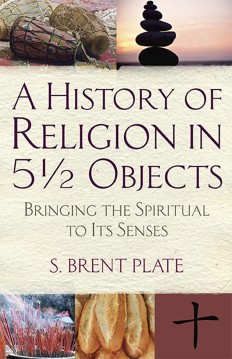As atheists communities continue to grow, some people are asking: If rituals help bind religious communities, do atheist communities need rituals?
To learn more I reached out to S. Brent Plate, author of the new book A History of Religion in 5½ Objects: Bringing the Spiritual to Its Senses. The visiting associate professor of religious studies at Hamilton College and co-founder and managing editor of Material Religion: The Journal of Objects, Art, and Belief, Plate has written for the Washington Post and Huffington Post.
Below we discuss atheist rituals, the connection between art and blasphemy, and why religion is about more than just belief.
Chris Stedman: What inspired you to write A History of Religion in 5½ Objects?
S. Brent Plate: Much of the initial impulse came from the story I tell in the book: My five year-old daughter playing at a beach in San Diego, not wanting to leave, and insisting that if she must leave she had to bring something with her, and so she ran and picked up this big rock.
I never told her how important stones were in religious traditions, but she instinctively knew that this object could carry the weight of the memories for the day with her. The rock now sits in her bedroom, and has become a type of personal relic for her.
Was my daughter’s action religious? Maybe. But it is true that many religious traditions have performed nearly identical activities. It’s that similarity I wanted to explore.
CS: You’ve previously written on blasphemy in art. What is it about art and objects—sacred or profane—that so frequently inspires either connection or condemnation?
SBP: I’m beginning to believe that we moderns are functional animists. We spend a lot of time disavowing the magical properties of things—“We’re not like those fetishists”—but in practice we are touching and eating and smelling and being effected by the objects around us. We are stirred to anger or incited to revolt at the appearance of images. Our sensual lives are much more profound, much more transcendent, than we generally allow—and I’m trying to unearth some of those sense-based emotions as primary to our spiritual lives.
CS: Why do you think atheists would be interested in A History of Religion in 5½ Objects?
SBP: The “½” in my title is about us humans as incomplete creatures, always seeking our other half. Theists tend to believe they find their fulfillment in a divine being. Many others believe they will find another human, a “soulmate.” I wanted to show that our desiring bodies are also fulfilled by the sights and sounds and smells we encounter.
Further, while religious traditions may ostensibly be about connecting us with God, the Goddess, or spirits, they also truck in the stuff of things, and have known of the power of the senses for thousands of years, with or without a divine source.
CS: Community building is a big topic of conversation among atheists, with nontheistic communities like Sunday Assembly growing rapidly. This has inspired debate about whether or not nonreligious nontheists should develop rituals and symbols—and if so, how. What can atheists learn from how religion has used objects and engaged the senses?
SBP: As a scholar in the humanities who has spent the last two decades traveling, observing, reading, and exploring arts and rituals, I’m increasingly convinced that we do not live full human lives without rituals, symbols, and mythologies. These are the things that bind us together, give meaning, and make us “whole.”
Whether or not nontheistic groups want to develop rituals and symbols is somewhat beside the point. Rituals and symbols will organically and inevitably develop in the midst of groups. It doesn’t take a God to create a liturgy, but it does take human bodies gathering together for like-bodied purposes.
CS: Some atheists speak of religion as if it is largely about belief. In A History of Religion in 5 1/2 Objects, you write, “Too often religion is explained as a ‘set of beliefs,’ which primarily exist in the thought processes of the brain… Religion, on this popular but ultimately misguided account, is about intellectual decisions regarding theism or atheism or polytheism, about correct thinking… But this is to put the proverbial cart before the horse. There is no thinking without first sensing.” How do you think this understanding of religion might impact how some atheists consider and approach religious differences and disagreements?
SBP: I think much of what passes as “atheism” in the English-speaking world is simply anti-Protestantism. The “religion equals set of beliefs in God” is an old Protestant idea, solidified in Webster’s nineteenth-century dictionary. In short, atheism is not the antonym of religion. It is the antonym of a particular idea of religion as an intellectual enterprise.
Once one begins to have a broad-minded view of religious life and practice as it actually exists around the world, it becomes clear that while deities are often involved, they are not necessarily central. Even the theistic traditions “speak” about God a good deal, but their everyday religious life and experience is about human bodies communing together and with objects. “Atheistic religion” is not an oxymoron.
CS: How does this discussion connect to interfaith dialogue?
SBP: I’m intrigued by the possibilities for objects to become focal points for interreligious dialogue. The focus is not whether we all believe in the same God, or read a single sacred text, but whether we all eat some kind of bread, or burn candles, or play music. Such sensual focus sets us off on a different path.







